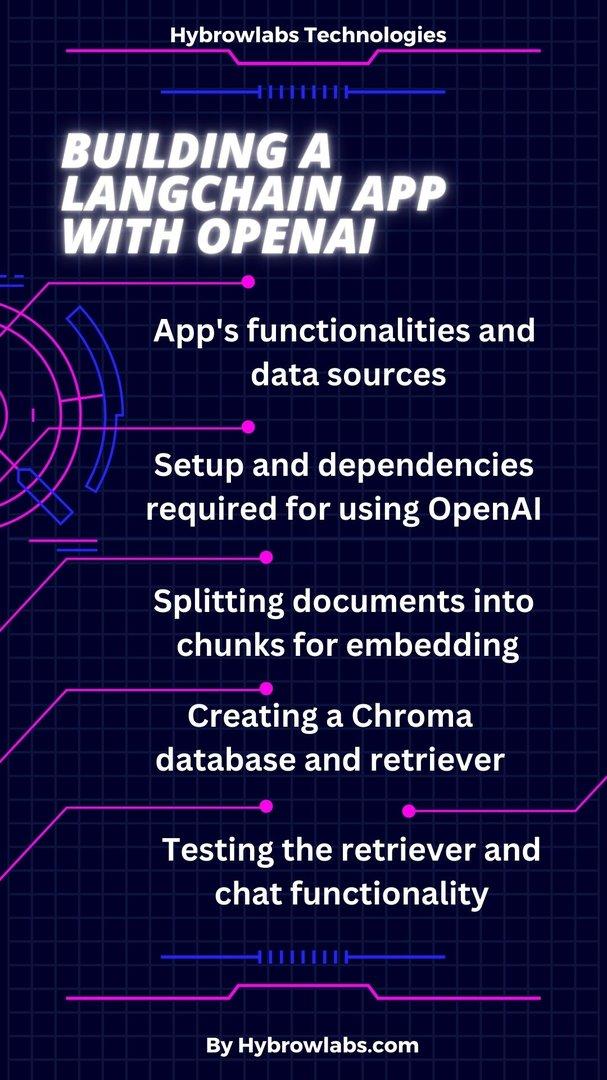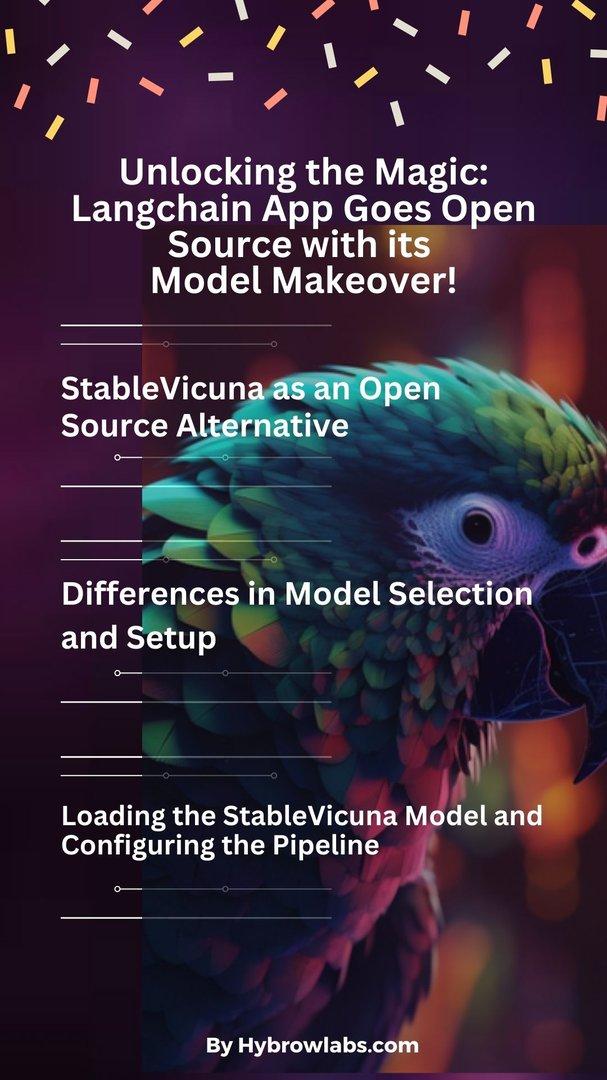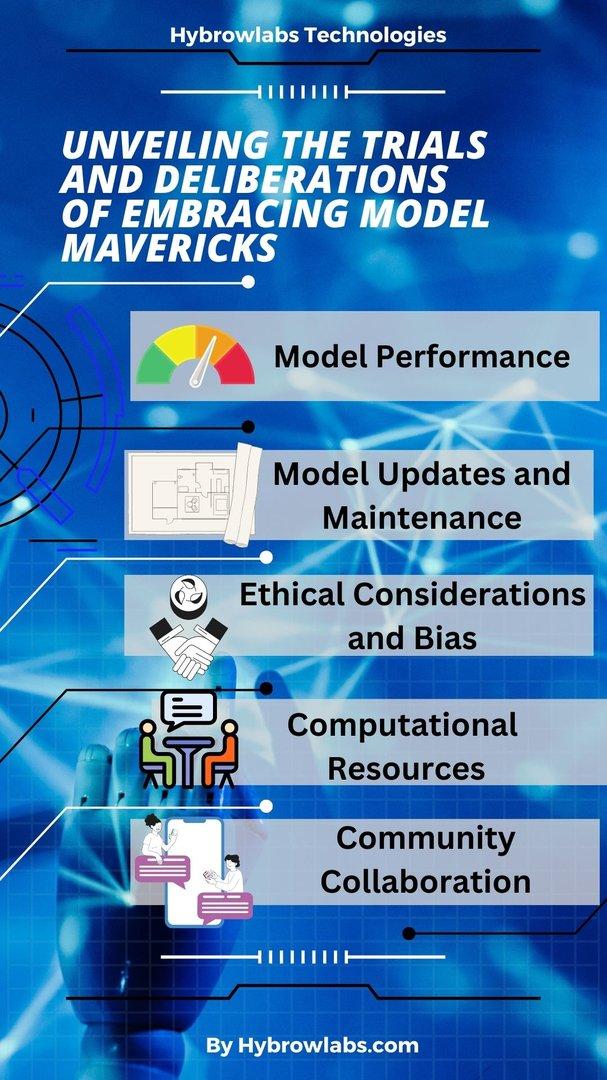In today's rapidly evolving technological landscape, the LangChain app has emerged as a powerful tool for language processing, developed by OpenAI. With its ability to generate informative and contextually relevant responses, LangChain has found applications in diverse domains such as education, research, and customer support. However, the decision to transition from the closed-source OpenAI platform to an open source model can unlock a myriad of opportunities for further development and community collaboration. This article delves into the process of converting a LangChain app from OpenAI to open source, exploring the advantages and challenges associated with this transition.
What is LangChain App?

The LangChain app is designed to facilitate seamless language understanding and generation. By leveraging cutting-edge natural language processing techniques, it empowers users to extract valuable information, engage in contextual conversations, and retrieve relevant documents. Key points to consider regarding the LangChain app include:
- Language Processing: LangChain employs state-of-the-art language models to comprehend and interpret user queries in a natural and intuitive manner.
- Document Retrieval: With an extensive database and intelligent search algorithms, the app efficiently retrieves relevant documents based on user input, facilitating quick access to information.
- Text Summarization: LangChain excels at summarizing lengthy texts, providing concise and coherent summaries that capture the key ideas and salient points.
- Contextual Chat: The app goes beyond simple question-answer interactions by engaging users in contextual conversations, offering a dynamic and interactive experience.
B. Transitioning from OpenAI to Open Source
Transitioning from the OpenAI platform to an open source model involves significant changes in the underlying architecture and components of the LangChain app. Considerations during this transition include:
- Open Source Alternatives: Exploring open source alternatives to replace the proprietary language generation component, such as the StableVicuna model, which offers similar capabilities and fosters community collaboration.
- Codebase Modification: Adapting the existing LangChain codebase to seamlessly integrate the open source model, ensuring compatibility and optimal performance.
- Workflow and Development Process: Adjusting the development workflow to embrace open source practices, such as version control, issue tracking, and community contributions.
C. Importance and Benefits of Open Sourcing the App
Open sourcing the LangChain app brings forth a range of benefits that contribute to its growth and improvement. The significance of open sourcing includes:
- Collaboration and Innovation: By making the app open source, developers, researchers, and users can collaborate, share insights, and collectively enhance the functionality and capabilities of LangChain.
- Transparency and Trust: Open sourcing fosters transparency, allowing users to inspect the codebase, understand the system's behavior, and address concerns related to biases or ethical considerations.
- Community Contribution: Opening the app to the wider community encourages contributions in the form of bug fixes, feature additions, and performance optimizations, ultimately enhancing the overall user experience.
- Accessibility and Affordability: Open sourcing LangChain democratizes access to advanced language processing tools, enabling individuals and organizations with limited resources to leverage its capabilities for their specific needs.
In the next sections of this article, we will delve deeper into the process of building a LangChain app with OpenAI and explore the intricacies of converting to open source models.
II. Building a LangChain App with OpenAI

A. Overview of the app's functionalities and data sources
The LangChain app built with OpenAI offers a range of powerful functionalities for language processing. It leverages advanced natural language processing models to provide accurate and informative responses to user queries. The app's capabilities include document retrieval, text summarization, and contextual chat.
To ensure the app's effectiveness, it relies on various data sources. These sources may include a diverse collection of text files and EPUB documents. By incorporating a wide range of content, the app can provide comprehensive and contextually relevant information to users.
B. Setup and dependencies required for using OpenAI
To build the LangChain app with OpenAI, several setup steps and dependencies are necessary. Firstly, developers need to create an OpenAI account and obtain the required API keys. These keys enable access to OpenAI's language models and services.
Next, the app's development environment must be set up. This typically involves installing the necessary programming libraries and frameworks, such as Python and relevant packages like TensorFlow or PyTorch. These dependencies provide the foundation for working with OpenAI's models and APIs.
C. Loading and processing text files and EPUBs
The LangChain app allows users to work with various types of textual content, including text files and EPUBs. To process these files, developers implement mechanisms to load and extract the relevant information. This step involves reading the content of the files and preparing them for further analysis and embedding.
D. Splitting documents into chunks for embedding
Large documents are often split into smaller chunks to facilitate efficient processing and embedding using OpenAI's language models. By dividing the content into manageable segments, developers can extract the essential information and generate embeddings for each section separately. This approach helps maintain context and ensures accurate responses.
E. Generating embeddings using OpenAI
The core of the LangChain app's language processing capabilities lies in generating embeddings. Embeddings are numerical representations of text that capture the semantic meaning and context of the content. OpenAI's models are utilized to generate these embeddings, providing a rich representation of the text data.
F. Creating a Chroma database and retriever
To facilitate document retrieval within the LangChain app, developers create a Chroma database. The Chroma database indexes the embeddings of the documents, enabling efficient and quick retrieval based on similarity scores. This setup allows users to find relevant documents that match their queries effectively.
G. Testing the retriever and chat functionality
Before deploying the app, rigorous testing of the retriever and chat functionality is essential. This involves verifying the accuracy and relevance of the retrieved documents and evaluating the quality of the app's responses. Testing ensures that the LangChain app functions as intended, providing users with reliable and valuable information.
H. Customizing the responses to mimic the expert's voice
To enhance the user experience, developers can customize the app's responses to mimic the voice of an expert in the domain. By fine-tuning the language model and incorporating specific domain knowledge, the app can generate responses that align with the desired expertise and tone. This customization adds a personal touch and helps create a more engaging and informative interaction for users.
Converting to Open Source Models

A. Overview of StableVicuna as an Open Source Alternative
StableVicuna is an open source alternative that can be utilized to replace the proprietary language generation component of the LangChain app. Developed by a collaborative community of researchers and developers, StableVicuna offers a powerful and customizable language model that can be tailored to specific needs. It is designed to provide high-quality language generation while maintaining transparency and flexibility.
B. Differences in Model Selection and Setup
- Model Selection: When transitioning to StableVicuna, careful consideration should be given to selecting an appropriate language model. The choice depends on factors such as the desired language fluency, computational resources available, and the specific domain of application.
- Setup Process: Setting up StableVicuna involves installing the necessary dependencies and configuring the pipeline for language generation. The process may vary depending on the programming language and framework used. It is important to follow the documentation provided by StableVicuna and ensure compatibility with the existing codebase.
C. Loading the StableVicuna Model and Configuring the Pipeline
To integrate the StableVicuna model into the LangChain app, the model needs to be loaded and configured correctly. This typically involves initializing the model object, loading the weights and parameters, and setting up the appropriate tokenization and language generation pipeline. The specific steps may vary based on the framework being used.
D. Testing the Open Source Model's Performance and Responses
After the integration of the StableVicuna model, it is essential to thoroughly test its performance and the quality of its generated responses. This testing phase helps ensure that the model produces accurate, coherent, and contextually relevant output. Test various scenarios and input types to assess the model's ability to handle different queries and generate meaningful responses. Compare the results with the previous OpenAI-based implementation to identify any discrepancies or areas for improvement.
Challenges and Considerations in Using Open Source Models

- Model Performance: Open source models may have different performance characteristics compared to proprietary solutions. It is important to evaluate and address any differences in language fluency, response quality, and response latency.
- Model Updates and Maintenance: Open source models require active maintenance and updates to incorporate the latest advancements and address potential vulnerabilities. Ensure that a robust community exists around the chosen open source model to support ongoing development.
- Ethical Considerations and Bias: Just like proprietary models, open source models can also exhibit biases or generate inappropriate content. It is crucial to monitor and address these concerns by implementing ethical guidelines, bias mitigation techniques, and community feedback loops.
- Computational Resources: Open source models may have specific requirements for computational resources such as processing power, memory, and storage. Ensure that the system hosting the LangChain app meets these requirements to maintain optimal performance.
- Community Collaboration: Leveraging open source models encourages collaboration within the community. Engage with developers, researchers, and users to contribute improvements, identify and resolve issues, and collectively enhance the capabilities of the LangChain app.
By embracing StableVicuna and open source models, the LangChain app can benefit from community involvement, transparency, and flexibility while delivering powerful and customizable language generation capabilities.
Comparing OpenAI and Open Source Approaches
A. Evaluating the Quality of Responses and Language Generation
One crucial aspect of comparing OpenAI and open source approaches is the evaluation of response quality and language generation. OpenAI models, such as GPT-3, have been extensively trained on vast amounts of data, resulting in impressive language generation capabilities. The responses tend to be coherent, contextually relevant, and exhibit a high degree of fluency. However, they may occasionally produce incorrect or nonsensical answers.
In contrast, open source models, like StableVicuna, provide an alternative that can be fine-tuned and customized to specific use cases. The quality of responses may depend on the training data and fine-tuning process. While open source models might not match the scale and diversity of data used by large-scale proprietary models, they can offer satisfactory performance for specific domains or applications.
B. Analyzing the Advantages and Disadvantages of Each Approach
Both OpenAI and open source approaches have their advantages and disadvantages. OpenAI models are known for their impressive language capabilities, providing a reliable out-of-the-box solution. The extensive pre-training and fine-tuning processes ensure high-quality responses across a wide range of topics. However, OpenAI models can be cost-prohibitive, and their proprietary nature limits user customization and direct engagement with the model's development.
On the other hand, open source models offer flexibility, transparency, and community-driven development. They provide the opportunity for customization and fine-tuning to specific requirements. Additionally, open source models are often more affordable and accessible to a broader user base. However, open source models might require more technical expertise to set up and fine-tune, and their performance may not always match that of large-scale proprietary models.
C. Considerations for Choosing between OpenAI and Open Source Models
When deciding between OpenAI and open source models, several considerations come into play. The specific use case and domain requirements play a crucial role. If the task requires a broad understanding of diverse topics and high-quality language generation, an OpenAI model might be the preferred choice. However, if customization, cost-effectiveness, and transparency are prioritized, open source models offer significant advantages.
Resource availability and technical expertise should also be considered. OpenAI models often require substantial computational resources and may have usage restrictions, whereas open source models can be deployed on a wider range of hardware and may have more flexible usage policies.
D. Discussing the Potential for Future Model Advancements
Both OpenAI and open source models are subject to continuous development and advancements. OpenAI is actively working on refining their models and introducing new versions that address limitations and enhance performance. Additionally, the open source community is constantly improving existing models and developing new ones, driven by collaborative efforts and research breakthroughs.
The future of language models holds promise, with advancements in areas like bias mitigation, controllability, and fine-tuning techniques. As the field progresses, open source models have the potential to catch up with proprietary models, offering even more competitive alternatives.
Conclusion
Converting a LangChain app from OpenAI to open source provides numerous benefits, including collaboration, transparency, and wider accessibility. While OpenAI models offer impressive language generation capabilities, open source models present an alternative that can be customized and fine-tuned to specific use cases. Evaluating the quality of responses and considering the advantages and disadvantages of each approach are essential when choosing between OpenAI and open source models. Factors such as the specific use case, resource availability, and technical expertise play a crucial role in the decision-making process.
The field of language models continues to advance, with both proprietary and open source models pushing the boundaries of language generation. As the open source community thrives and researchers make progress, future model advancements hold the potential to further bridge the gap between OpenAI and open source models. By embracing open source alternatives, developers and users can contribute to the growth and democratization of language technologies, ultimately leading to more inclusive and powerful language processing applications. For more such updates and solution, you can reach us at Hybrowlabs technologies.
FAQ
Q1: What is the main advantage of converting a LangChain app from OpenAI to open source?
A1: The main advantage is the increased collaboration, transparency, and wider accessibility that open source offers. Converting to open source allows for customization, fine-tuning, and community-driven development, providing more control and flexibility over the app's functionalities.
Q2: How does the quality of responses differ between OpenAI and open source models?
A2: OpenAI models, such as GPT-3, are known for their impressive language generation capabilities and provide reliable out-of-the-box solutions. Open source models, while they may not match the scale and diversity of data used by large-scale proprietary models, can offer satisfactory performance for specific domains or applications, depending on the training data and fine-tuning process.
Q3: Which factors should I consider when choosing between OpenAI and open source models for my LangChain app?
A3: Several factors should be considered, including the specific use case and domain requirements. If broad understanding of diverse topics and high-quality language generation are essential, an OpenAI model might be the preferred choice. On the other hand, if customization, cost-effectiveness, and transparency are prioritized, open source models provide significant advantages.
Q4: Do open source models require more technical expertise to set up and use compared to OpenAI models?
A4: Open source models may require more technical expertise initially for setup and fine-tuning, as they often involve configuring the model, loading the necessary dependencies, and training or fine-tuning on specific data. However, with the growing availability of user-friendly tools and documentation, the barrier to entry is decreasing, making open source models more accessible to a wider range of users.
Q5: What does the future hold for language models, both OpenAI and open source?
A5: The future of language models looks promising, with continuous advancements in both OpenAI and open source models. OpenAI is actively refining their models and introducing new versions to address limitations and enhance performance. Simultaneously, the open source community is constantly improving existing models and developing new ones, driven by collaborative efforts and research breakthroughs. As the field progresses, open source models have the potential to catch up with proprietary models, offering even more competitive alternatives.



.jpg)


a3dc85.jpg)
.jpg)
fd8f11.png)


.jpg)
.jpg)